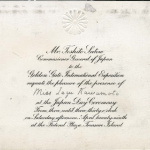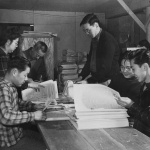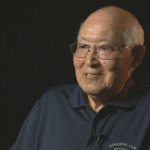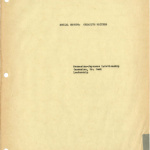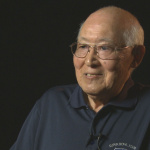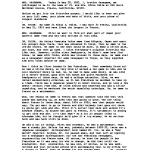Miya Sannomiya Kikuchi
| Name | Miya Sannomiya Kikuchi |
|---|---|
| Born | October 17 1902 |
| Died | 1983 |
| Birth Location | HI |
| Generational Identifier |
Cultural ambassador and journalist. Miya Sannomiya Kikuchi (1902–83) was a pioneering Nisei woman leader whose life was shaped by multiple forms of discrimination and by the larger historic forces of the times she lived in. However, she took advantages of the opportunities presented to her to become a leading voice of her generation before the war.
Early Life
Miyako Sannomiya was born on October 17, 1902, in Hawai'i to Umegoro and Wasa Sannomiya, immigrants from Kumamoto prefecture. In 1906, the family moved to San Francisco just after the great earthquake. It was also soon after the city that had become ground zero of the anti-Japanese movement passed a law requiring Japanese American children to attend segregated schools. Her parents got around that law by sending her to school in Oakland.
After a stint farming in Klammath Falls, Oregon, the family returned to the Bay Area, where she graduated from grammar school at the top of her class. Having been converted to Christianity, she received a scholarship in 1913 to study at a Southern Methodist High School in Alabama. Taken aback by segregation and by being treated with condescension, she returned after a year attending high school in Oakland. While in high school, she ended up helping her father and other Issei with alien land law related litigation as an interpreter, being one of the few Nisei old enough to do so.
She entered the University of California in 1920, intending to become a doctor. Though she did well in school, her education was interrupted frequently by the need to help with the family farm, delaying her graduation.
Japan Representative
Beginning in 1925, the San Francisco newspaper Nichibei Shimbun began sponsoring kengakudan, study tours of Japan for outstanding Nisei youth. She was selected for the second tour, which took place in the spring of 1926. It was a life-changing event. The tour, which included ten Nisei, included two months of travel in Japan and saw the participants meet Japanese dignitaries and receive special tours intended to groom the young people for a future role as cultural ambassadors between Japan and the U.S. Chosen as a group leader, kengakudan historian Yuji Ichioka describes her as "by consensus, the maturest and most capable of all the members." [1]
But her role as cultural ambassador would have to wait. In 1927, her father died suddenly, reportedly leaving the family with $160,000 in debt. Forced to quit school, she returned to Stockton to run the family farm in an effort to repay the debt. After three years, she was able to pay off much of the debt and sold the farm. Nearing thirty years old, she shifted her major to German so as to be able to graduate as quickly as possible and did graduate in May of 1930.
As was the case of other outstanding older Nisei, professional jobs outside the ethnic community were difficult to come by. Familiar with her from the kengagudan, the Nichibei Shimbun offered her a job as English editor. She became known for a column called "Junior and Senior Club," written under the pseudonym "Aunt Mia." As her biographer Eriko Yamamoto writes, "Nisei boys and girls eagerly wrote and poured their hearts out to her, because their parents did not understand English or their problems growing up as Nisei, or because they were living in the remote countryside." [2]
When Prince Iyesato Tokugawa visited San Francisco, she interviewed him for the newspaper, since she had met him on the kengakudan. He remembered her favorably and encouraged her to return to Japan to continue to study, where he would help introduce her to key people. She saved money for two years—apparently returning to farming—and journeyed to Japan in 1933. She studied at the Women's Christian Temperance Union, assisted two prominent Japanese Christian women to write a book in English, and toured Manchuria.
In 1934, the Kokusai Bunka Shinkokai (Society for International Cultural Relations) was formed, a governmental agency created to promote "mutual understanding" and serve as a PR wing for Japan overseas. Again referred by the prince, she was offered a position. She translated speeches and written materials in English and also did presentations in English about Japanese culture in throughout the U.S. Her U.S. presentations were often done in tandem with Henry Toshiro Shimanouchi, an Issei who had been raised in California since age one; he spoke on political issues, while she focused on cultural topics.
In a 1935 report, she embraced the concept of the Nisei as "bridge of understanding":
... it is necessary to give many Nisei opportunities to see and experience the beauties that Japan can offer and then return them to their own society. They will be important people in building the foundation of a 'bridge of understanding' as teachers, lecturers or respectable citizens of American society through their daily contact with Americans. I myself came to know that, as a Nisei, I could reach typical Americans through my lectures, and also felt that by seeing Japan, I was able to become a more valuable, useful American citizen that would contribute to American life and culture." [3]
After helping to select the site of what would become the New York office of the Japan Institute in the newly constructed Rockefeller Center and helping to set it up, she resigned from the KBS. She was becoming increasingly uncomfortable with Japanese militarism and was undoubtedly pushing the boundaries of accepted roles for Nisei women as a single working woman now thirty-six years old. Upon her resignation, she married a Los Angeles based Issei dentist and widower, Yoriyuki Kikuchi.
World War II and Final Years
Her timing in leaving her position with KBS proved fortuitous, as Japan and U.S. were at war three years later. Caught up in the mass removal of Japanese Americans from the West Coast, she, her husband, and her adult stepchildren were among those who left for Manzanar early to help set up the camp. Both worked for the War Relocation Authority , Miya for the family relations department, and Yoriyuki as chief of the dental clinic. Their actions marked them as collaborators, and Yoriyuki was apparently among those targeted in the 1942 Manzanar riot . They left camp as soon as they could, leaving for Chicago and then New York. She was recruited to teach Japanese at Columbia for U.S. Navy officers.
After the war, they returned to Los Angeles. She did not take up a prominent public role after the war and was a housewife and assisted with her husband's practice. After husband died, she lived in the Japanese Retirement Home in Los Angeles and died in 1983.
For More Information
Hosokawa, Bill. JACL in Quest of Justice: The History of the Japanese American Citizens League . New York: William Morrow, 1982.
Ichioka, Yuji. "Kengakudan: The Origin of Nisei Study Tours of Japan." California History 73.1 (spring 1994): 31-43.
———. Before Internment: Essays in Prewar Japanese American History . Edited by Gordon H. Chang and Eiichiro Azuma. Stanford: Stanford University Press, 2006.
Yamamoto, Eriko. "Miya Sannomiya Kikuchi: A Pioneer Nisei Woman's Life and Identity." Amerasia Journal 23.3 (winter 1997): 72-101.
Footnotes
- ↑ Yuji Ichioka, Before Internment: Essays in Prewar Japanese American History , eds. Gordon H. Chang and Eiichiro Azuma (Stanford: Stanford University Press, 2006), 69.
- ↑ Eriko Yamamoto, "Miya Sannomiya Kikuchi: A Pioneer Nisei Woman's Life and Identity," Amerasia Journal 23.3 (winter 1997), 84.
- ↑ Yamamoto, "Miya Sannomiya Kikuchi," 88.
Last updated July 7, 2020, 7:46 p.m..

